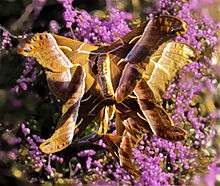Samia cynthia
| Ailanthus silkmoth | |
|---|---|
| | |
| adult male | |
| | |
| adult female | |
| Scientific classification | |
| Kingdom: | Animalia |
| Phylum: | Arthropoda |
| Class: | Insecta |
| Order: | Lepidoptera |
| Family: | Saturniidae |
| Genus: | Samia |
| Species: | S. cynthia |
| Binomial name | |
| Samia cynthia (Drury, 1773) | |
| Synonyms | |
| |
Samia cynthia (ailanthus silkmoth) is a saturniid moth, used to produce silk fabric but not as domesticated as the silkworm, Bombyx mori. The moth has very large wings of 113–125 mm, with a quarter-moon shaped spot on both the upper and lower wings, whitish and yellow stripes and brown background. There are "eyespots" on the outer fore wings.
Eri silk
The common name 'Ailanthus silkmoth' refers to the host plant Ailanthus. There is a subspecies, S. cynthia ricini in India that feeds upon the leaves of castor bean, and is known for the production of eri silk, and is often referred to by the common name Eri silkmoth.
The eri silk worm is the only completely domesticated silkworm other than Bombyx mori. The silk is extremely durable, but cannot be easily reeled off the cocoon and is thus spun like cotton or wool.[1]

Range
Peigler & Naumann (2003),[2] in their revision of the genus Samia, listed material of true Samia cynthia examined as follows:
Indigenous populations
Asia: China (Zhejiang, Shanghai, Jiangxi, Jiangsu, Shandong, Beijing, Shanxi, Liaoning, Heilongjiang); Korea (North Pyongan, South Pyongan, Pyongyang, Kangwon, South Kyongsan)
Introduced Populations (escaped from cultivation or introduced and naturalized)
Asia: Japan; India
Australasia: Australia
America: Canada; United States; Venezuela; Uruguay; Brazil
Africa: Tunisia
Europe: France; Austria; Switzerland; Germany; Spain; Bulgaria; Italy.
Life cycle
%2C_Mariposario_de_Icod_de_los_Vinos%2C_Tenerife%2C_Espa%C3%B1a%2C_2012-12-13%2C_DD_01.jpg)
Eggs
Whitish eggs, marked with brown, are laid in rows of 10 to 20 on leaves in crescents. Hatching takes 7–10 days.
Larvae
Larvae are gregarious and yellow at first. Later instars are solitary, and whitish-green with white tubercules along the back, and small black dots. 5 instars, maximum length 70–75 mm.
Pupae
A silken off-white to grey cocoon is spun on the leaves of the host. It has an obvious escape hatch.
Adults
Females prepare to mate in the evening or night after emerging in late morning. Adult flight is during May and June in northern Europe, as one generation. In southern Europe a partial second generation may occur in September.
Food plants
Larvae will feed on other trees and shrubs, but all eggs are laid on Tree of Heaven (Ailanthus altissima) and growth is best on it. This tree is commonly grown as an ornamental in cities. The subspecies S. cynthia ricini feeds upon castor bean.
Footnotes
References
Tuskes, PM, JP Tuttle and MM Collins. 1996. The wild silk moths of North America. Cornell University Press. ISBN 0-8014-3130-1 Saturnids of Western Palearctic
External links
| Wikimedia Commons has media related to Samia cynthia. |
- Butterflies and Moths of North America Ailanthus silkmoth Samia cynthia (Drury, 1773)
- Giant Moths (Saturniidae) of Prince Edward Island, Canada: Samia Cynthia (Drury 1773)
- Cynthia moth (Samia cynthia) mating (YouTube-Video).
- Cynthia moth (Samia cynthia) laying eggs (YouTube-Video).